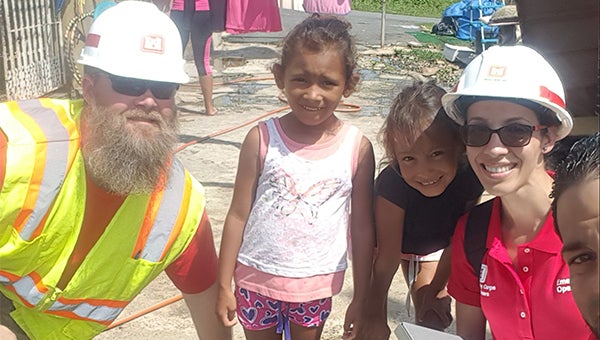ERDC civil engineer tries to help her homeland
Published 6:40 pm Friday, December 1, 2017

- Ramon Pierce and Marielys Ramos-Villanueva doing assesments in Dorado, PR. Ramos-Villanueva has been volunteering with the Corps of Engineers’ Blue Roof Project in Puerto Rico since Oct. 7.
Marielys Ramos-Villanueva could barely even talk about the devastation she’s experienced in Puerto Rico without breaking into tears.
The bare trees where hurricane winds had blown away the leaves, collapsed bridges, homes destroyed by landslides and her family who finally had power restored Thanksgiving Day, almost two months since Hurricane Maria had ripped through her family’s home in Puerto Rico.
A native of the island, Ramos-Villanueva has worked as a research civil engineer at the U.S. Army Engineer Research and Development Center in Vicksburg since 2013. In the weeks after Hurricane Maria became the second major hurricane to hit Puerto Rico in 2017, Ramos-Villanueva and 19 other Puerto Rican natives who attended the University of Puerto Rico at Mayaguez and currently work at ERDC deployed to the island to help with the rebuilding efforts.
“Since the day the hurricane hit the island we knew that they were going to ask for volunteers from different federal agencies,” Ramos-Villanueva said. “We put together a list of Puerto Ricans who work at ERDC so we know the system, we know the language, we know the people, we know the roads. We started looking for opportunities to come here to help.”
Ramos-Villanueva arrived in Puerto Rico Oct. 7 and she expects to be there until mid to late January after extending her stay multiple times to help.
Arriving soon after the hurricane hit, Ramos-Villanueva said the condition of the island “was really shocking.”
“It was so different,” she said. “First the weather, it was always raining, which didn’t help. The trees didn’t have any leaves, which never happens on the island because here it is like summer every day. Every thing looked really sad. It was pitch black at night. There was no power anywhere and it was really sad.”
Ramos-Villanueva and the other volunteers from ERDC were assigned to help with the Corps of Engineers’ Blue Roof project, which works to install heavy-duty blue tarps on the roofs of houses damaged in the storm, allowing people to return home.
Ramos-Villanueva spent the first few weeks processing work orders for the blue roof project and she currently serves as the area leader for the northern and central regions of the county.
“I have been staying in the municipality called Dorado,” Ramos-Villanueva said. “I have been working in the mountains. I just stay there because we have the office for coordination for the groups.”
Although much of the country has made extensive progress in terms of returning power, Ramos-Villanueva said her area of responsibility continues to struggle due to its mountainous terrain.
“Around the island, you have highways going around and there is easy access to work in those parts of the island,” she said. “When you go to the center it is smaller roads, a lot of curves, a lot of very steep roads, bridges are collapsed there. In the center of the island is where the help is still most needed. Getting there to work is really hard.”
Ramos-Villanueva oversees 85 people working in 19 municipalities. Due to the challenges in their area, Ramos-Villanueva said they have to make sure they are back before daylight disappears or it won’t be safe to travel.
“If they are in the mountains, some bridges collapsed and you have to cross the river with the cars to get back to the hotel,” she said. “You can’t see the level of the water at the moment so they have to go through those roads, 5 p.m. is the latest they can use those roads.”
Despite the devastation around them, a community has formed among the volunteers, which Ramos-Villanueva said has enabled them to persevere through all the challenges they have faced.
“It is not just me, I have here in my group at least five Puerto Ricans,” she said. “Every night we come back and tell stories and get support from each other. At the beginning it was really intense emotionally
“Sometimes they are good stories, sometimes they are really sad. Others are really funny like you go to a house and they have a goat in the front yard or they want you to hold the little pig that they have as a pet.”
Ramos-Villanueva and her team have also been able to draw strength from the people with whom they interact because no matter the circumstances they have refused to allow the hurricanes to defeat them.
“No matter the conditions around them, the people in the houses are always so happy,” Ramos-Villanueva said. “They don’t have water. They don’t have electricity, the roads are missing and they keep offering you water and food and snacks. They want to give you whatever they have … We go there. We talk to them. They tell their story and I think that helps them too, to have somebody to tell their story.”
Ramos-Villanueva’s deployment was only supposed to last a month, but she extended through mid-December and is now working to extend a second time through mid-January to help with the inspection phase now that the majority of the tarps have been installed.
“I want to stay as long as I can to help,” she said. “When I was leaving before extending and had my date to leave, I was feeling like I was leaving everything incomplete here. I wanted to somehow help to guide this through the end.”





